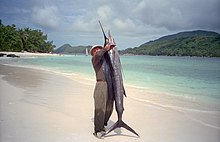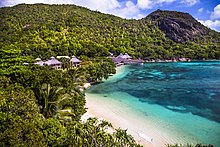Environmental Issues In Seychelles
Seychelles was uninhabited prior to being encountered by Europeans in the 16th century. It faced competing French and British interests until it came under full British control in the late 18th century. Since proclaiming independence from the United Kingdom in 1976, it has developed from a largely agricultural society to a market-based diversified economy, characterized by service, public sector, and tourism activities. From 1976 to 2015, nominal GDP grew nearly 700%, and purchasing power parity nearly 1600%. Since the late 2010s, the government has taken steps to encourage foreign investment.
As of the early 21st century, Seychelles has the highest nominal per capita GDP of any African nation. It has the highest Human Development Index ranking of any African country. According to the 2023 V-Dem Democracy indices, Seychelles is the 43rd-ranked electoral democracy worldwide and 1st-ranked electoral democracy in Africa.
Seychellois culture and society is an eclectic mix of French, British, and African influences, with infusions of Chinese and Indian elements. The country is a member of the United Nations, the African Union, the Southern African Development Community, and the Commonwealth of Nations.
History
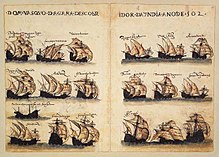
Seychelles was uninhabited until the 18th century when Europeans arrived with Indians, and enslaved Africans. It remained a British colony from 1814 until its independence in 1976. Seychelles has never been inhabited by indigenous people, but its islanders maintain their own Creole heritage.
Early history
Seychelles was uninhabited throughout most of recorded history, although simulations of Austronesian migration patterns indicate a good probability that Asians visited the islands. Tombs visible until 1910 at Anse Lascars on Silhouette Island have been conjectured to belong to later Maldivian and Arab traders visiting the archipelago. Vasco da Gama and his 4th Portuguese India Armada discovered the Seychelles on 15 March 1503; the first sighting was made by Thomé Lopes aboard Rui Mendes de Brito. Da Gama's ships passed close to an elevated island, probably Silhouette Island, and the following day Desroches Island. Later, the Portuguese mapped a group of seven islands and named them The Seven Sisters. The earliest recorded landing was in January 1609, by the crew of the Ascension under Captain Alexander Sharpeigh during the fourth voyage of the British East India Company.
A transit point for trade between Africa and Asia, the islands were said to be occasionally used by pirates until the French began to take control in 1756 when a Stone of Possession was laid on Mahé by Captain Nicholas Morphey. The islands were named after Jean Moreau de Séchelles, Louis XV's Minister of Finance.
In August 1770, the French ship Thélémaque under the command of Leblanc Lécore landed 28 people—15 white men and 13 enslaved men and women from Africa and India—on Ste. Anne Island.
The British frigate Orpheus commanded by Captain Henry Newcome arrived at Mahé on 16 May 1794, during the War of the First Coalition. Terms of capitulation were drawn up and on the next day, Seychelles was surrendered to the United Kingdom. Jean Baptiste Quéau de Quincy, the French administrator of Seychelles during the years of war with the United Kingdom, declined to resist when armed enemy warships arrived. Instead, he successfully negotiated the status of capitulation to Britain which gave the settlers a privileged position of neutrality.
Britain eventually assumed full control upon the surrender of Mauritius in 1810, formalised in 1814 at the Treaty of Paris. Seychelles became a crown colony separate from Mauritius in 1903. Elections in Seychelles were held in 1966 and 1970.

Independence
In 1976, Seychelles gained independence from the United Kingdom as a republic. It has since become a member of the Commonwealth. In the 1970s Seychelles was "the place to be seen, a playground for film stars and the international jet set". In 1977, a coup d'état by France Albert René ousted the first president of the republic, James Mancham. René discouraged over-dependence on tourism and declared that he wanted "to keep Seychelles for the Seychellois".
The 1979 constitution declared a socialist one-party state, which lasted until 1991.
In the 1980s there were a series of coup attempts against President René, some of which were supported by South Africa. In 1981, Mike Hoare led a team of 43 South African mercenaries masquerading as holidaying rugby players in the 1981 Seychelles coup d'état attempt. There was a gun battle at the airport, and most of the mercenaries later escaped in a hijacked Air India plane. The leader of this hijacking was German mercenary D. Clodo, a former member of the Rhodesian SAS. Clodo later stood trial in South Africa (where he was acquitted) as well as in his home country Germany for air piracy.
In 1986, an attempted coup led by the Seychelles Minister of Defence, Ogilvy Berlouis, caused President René to request assistance from India. In Operation Flowers are Blooming, the Indian naval vessel Vindhyagiri arrived in Port Victoria to help avert the coup.
The first draft of a new constitution failed to receive the requisite 60% of voters in 1992, but an amended version was approved in 1993.
In June 2012, during a conference at the United Nations Conference on Sustainable Development in Rio de Janeiro, a commitment was made by the Seychelles government to protect 30% of its 1.35 million square kilometre marine waters within the country's marine protected areas.
In January 2013, Seychelles declared a state of emergency when the tropical cyclone Felleng caused torrential rain, and flooding and landslides destroyed hundreds of houses.
Following the coup in 1977, the president always represented the same political party until the October 2020 Seychellois general election, which was historic in that the opposition party won. Wavel Ramkalawan was the first president who did not represent United Seychelles (the current name of the former Seychelles People's Progressive Front).
In January 2023, Seychelles announced its final stages of completing its marine spatial plan. It would become the second largest ocean area at 1.35 million km (520,000 sq mi) behind Norway, in support of its blue economy.
Politics
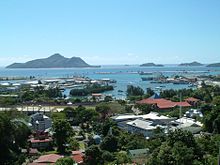
The Seychelles president, who is head of state and head of government, is elected by popular vote for a five-year term of office. The cabinet is presided over and appointed by the president, subject to the approval of a majority of the legislature. As of 2023, the president is Wavel Ramkalawan.
The unicameral Seychellois parliament, the National Assembly or Assemblée Nationale, consists of 35 members, 26 of whom are elected directly by popular vote, while the remaining nine seats are appointed proportionally according to the percentage of votes received by each party. All members serve five-year terms.
The Supreme Court of Seychelles, created in 1903, is the highest trial court in Seychelles and the first court of appeal from all the lower courts and tribunals. The highest court of law in Seychelles is the Seychelles Court of Appeal, which is the court of final appeal in the country.
Political culture

Seychelles' long-term president France-Albert René came to power after his supporters overthrew the first president James Mancham on 5 June 1977 in a coup d'état and installed him as president. René was at that time the prime minister. René ruled as a strongman under a socialist one-party system until 1993, when he was forced to introduce a multi-party system. He stepped down in 2004 in favour of his vice-president, James Michel, who was re-elected in 2006, 2011 and again in 2015. On 28 September 2016, the Office of the President announced that Michel would step down effective 16 October, and that Vice President Danny Faure would complete the rest of Michel's term.
On 26 October 2020, Wavel Ramkalawan, a 59-year-old Anglican priest, was elected the fifth President of the Republic of Seychelles. Ramkalawan was an opposition MP from 1993 to 2011, and from 2016 to 2020. He served as the Leader of the Opposition from 1998 to 2011 and from 2016 to 2020. Ramkalawan defeated incumbent Danny Faure by 54.9% to 43.5%. This marked the first time the opposition had won a presidential election.
The primary political parties are the former long-time ruling socialist People's Party (PP), known until 2009 as the Seychelles People's Progressive Front (SPPF) now called United Seychelles (US), and the socially liberal Seychelles National Party (SNP).
The election of the National Assembly was held on 22–24 October 2020. The Seychelles National Party, the Seychelles Party for Social Justice and Democracy and the Seychelles United Party formed a coalition, Linyon Demokratik Seselwa (LDS). LDS won 25 seats and US got 10 seats of the 35 seats of the National Assembly.
Foreign relations
Seychelles is a member of the United Nations, the African Union, the Indian Ocean Commission, La Francophonie, the Southern African Development Community and the Commonwealth of Nations.
Between 1979 and 1983, various plots to overthrow the non-aligned government of France-Albert Rene were, according to leading participants, supported by the United States, France, and South Africa. Commonly cited reasons for such attempts include Rene's socialist politics, his non-aligned stance toward the Western and Eastern Blocs, and the United States' military lease in the country, which was set to expire in 1990. All coup efforts in this period failed. Under the Obama administration, the US began running drone operations out of Seychelles. In the Spring of 2013, members of the Special-Purpose Marine Air-Ground Task Force Africa mentored troops in Seychelles, along with a variety of other African nations.
Military
The Military of Seychelles is the Seychelles People's Defence Force which consists of a number of distinct branches: an Infantry Unit and Coast Guard, Air Force and a Presidential Protection Unit. India has played and continues to play a key role in developing the military of Seychelles. After handing over two SDB Mk5 patrol vessels built by GRSE, the INS Tarasa and INS Tarmugli, to the Seychelles Coast Guard, which were subsequently renamed PS Constant and PS Topaz, India also gifted a Dornier 228 aircraft built by Hindustan Aeronautics Limited. India also signed a pact to develop Assumption Island. Spread over 11 km (4 sq mi), it is strategically located in the Indian Ocean, north of Madagascar. The island is being leased for the development of strategic assets by India. In 2018, Seychelles signed the UN treaty on the Prohibition of Nuclear Weapons.
Incarceration
In 2014, Seychelles had the highest incarceration rate in the world of 799 prisoners per 100,000 population, exceeding the United States' rate by 15%. However, the country's actual population was less than 100,000; as of September 2014, Seychelles had 735 actual prisoners, 6% of whom were female, incarcerated in three prisons.
The incarceration rate in Seychelles has since dropped significantly. It is no longer among the top ten countries with the highest rate of incarceration. In 2022, the incarceration rate was 287 per 100,000 population, being just the 31st highest in the world.
Modern piracy
Seychelles is a key participant in the fight against Indian Ocean piracy primarily committed by Somali pirates. Former president James Michel said that piracy costs between $7 million – $12 million a year to the international community: "The pirates cost 4% of the Seychelles GDP, including direct and indirect costs for the loss of boats, fishing, and tourism, and the indirect investment for the maritime security." These are factors affecting local fishing – one of the country's main national resources – which had a 46% loss in 2008–2009. International contributions of patrol boats, planes or drones have been provided to help Seychelles combat sea piracy.
Administrative divisions
Seychelles is divided into twenty-six administrative regions comprising all of the inner islands. Eight of the districts make up the capital of Seychelles and are referred to as Greater Victoria. Another 14 districts are considered the rural part of the main island of Mahé. Two more districts divide the island of Praslin and one covers La Digue as well as satellite and other Inner Islands. The rest of the Outer Islands (Îles Eloignées) make up the last district recently created by the tourism ministry.
|
Greater Victoria
|
Rural Mahé |
Praslin
La Digue and remaining Inner Islands
|
Geography
This section needs additional citations for verification. (February 2017) |
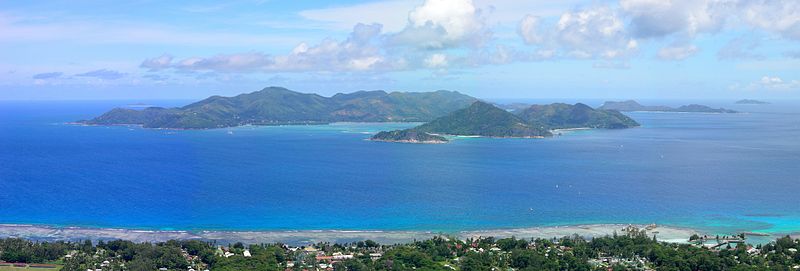
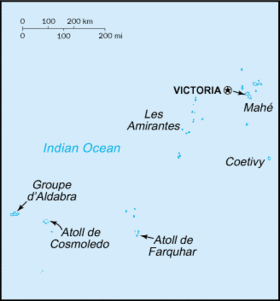
An island nation, Seychelles is located in the Somali Sea segment of the Indian Ocean, northeast of Madagascar and about 1,600 km (860 nmi) east of Kenya. The Constitution of Seychelles lists 155 named islands, and a further 7 reclaimed islands have been created subsequent to the publication of the Constitution. The majority of the islands are uninhabited, with many dedicated as nature reserves. Seychelles' largest island, Mahé, is located 1,550 km (835 nmi) from Mogadishu (Somalia's capital).
A group of 44 islands (42 granitic and 2 corallines) occupy the shallow waters of the Seychelles Bank and are collectively referred to as the inner islands. They have a total area of 244 km (94 sq mi), accounting for 54% of the total land area of the Seychelles and 98% of the entire population.
The islands have been divided into groups. There are 42 granitic islands known as the Granitic Seychelles. These are in descending order of size: Mahé, Praslin, Silhouette, La Digue, Curieuse, Félicité, Frégate, Ste. Anne, North, Cerf, Marianne, Grand Sœur, Thérèse, Aride, Conception, Petite Sœur, Cousin, Cousine, Long, Récif, Round (Praslin), Anonyme, Mamelles, Moyenne, Ile aux Vaches Marines, L'Islette, Beacon (Ile Sèche), Cachée, Cocos, Round (Mahé), L'Ilot Frégate, Booby, Chauve Souris (Mahé), Chauve Souris (Praslin), Ile La Fouche, Hodoul, L'Ilot, Rat, Souris, St. Pierre (Praslin), Zavé, Harrison Rocks (Grand Rocher).
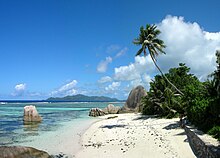
There are two coral sand cays north of the granitics on the edge of the Seychelles Bank: Denis and Bird. There are two coral islands south of the Granitic: Coëtivy and Platte.
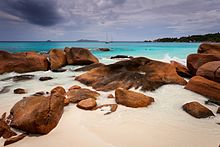
There are 29 coral islands in the Amirantes group, west of the granitic: Desroches, Poivre Atoll (comprising three islands—Poivre, Florentin and South Island), Alphonse, D'Arros, St. Joseph Atoll (comprising 14 islands—St. Joseph, Île aux Fouquets, Resource, Petit Carcassaye, Grand Carcassaye, Benjamin, Bancs Ferrari, Chiens, Pélicans, Vars, Île Paul, Banc de Sable, Banc aux Cocos and Île aux Poules), Marie Louise, Desnœufs, African Banks (comprising two islands—African Banks and South Island), Rémire, St. François, Boudeuse, Étoile, Bijoutier.
There are 13 coral islands in the Farquhar Group, south-southwest of the Amirantes: Farquhar Atoll (comprising 10 islands—Bancs de Sable, Déposés, Île aux Goëlettes, Lapins, Île du Milieu, North Manaha, South Manaha, Middle Manaha, North Island and South Island), Providence Atoll (comprising two islands—Providence and Bancs Providence) and St Pierre.

There are 67 raised coral islands in the Aldabra Group, west of the Farquhar Group: Aldabra Atoll (comprising 46 islands—Grande Terre, Picard, Polymnie, Malabar, Île Michel, Île Esprit, Île aux Moustiques, Ilot Parc, Ilot Émile, Ilot Yangue, Ilot Magnan, Île Lanier, Champignon des Os, Euphrate, Grand Mentor, Grand Ilot, Gros Ilot Gionnet, Gros Ilot Sésame, Héron Rock, Hide Island, Île aux Aigrettes, Île aux Cèdres, Îles Chalands, Île Fangame, Île Héron, Île Michel, Île Squacco, Île Sylvestre, Île Verte, Ilot Déder, Ilot du Sud, Ilot du Milieu, Ilot du Nord, Ilot Dubois, Ilot Macoa, Ilot Marquoix, Ilots Niçois, Ilot Salade, Middle Row Island, Noddy Rock, North Row Island, Petit Mentor, Petit Mentor Endans, Petits Ilots, Pink Rock and Table Ronde), Assumption Island, Astove and Cosmoledo Atoll (comprising 19 islands—Menai, Île du Nord (West North), Île Nord-Est (East North), Île du Trou, Goélettes, Grand Polyte, Petit Polyte, Grand Île (Wizard), Pagode, Île du Sud-Ouest (South), Île aux Moustiques, Île Baleine, Île aux Chauve-Souris, Île aux Macaques, Île aux Rats, Île du Nord-Ouest, Île Observation, Île Sud-Est and Ilot la Croix).
In addition to these 155 islands, as per the Constitution of Seychelles, there are 7 reclaimed islands: Ile Perseverance, Ile Aurore, Romainville, Eden Island, Eve, Ile du Port and Ile Soleil.
South Island, African Banks has been eroded by the sea. At St Joseph Atoll, Banc de Sable and Pelican Island have also eroded, while Grand Carcassaye and Petit Carcassaye have merged to form one island. There are also several unnamed islands at Aldabra, St Joseph Atoll and Cosmoledo. Pti Astove, though named, failed to make it into the Constitution for unknown reasons. Bancs Providence is not a single island, but a dynamic group of islands, comprising four large and about six very small islets in 2016.
Climate
The climate is very humid, as the islands are small, and is classified by the Köppen-Geiger system as a tropical rain forest (Af). The temperature varies little throughout the year. Temperatures on Mahé vary from 24 to 30 °C (75 to 86 °F), and rainfall ranges from 2,900 mm (114 in) annually at Victoria to 3,600 mm (142 in) on the mountain slopes. Precipitation levels are somewhat less on the other islands.
During the coolest months, July and August, the average low is about 24 °C (75 °F). The southeast trade winds blow regularly from May to November, and this is the most pleasant time of the year. The hot months are from December to April, with higher humidity (80%). March and April are the hottest months, but the temperature seldom exceeds 31 °C (88 °F). Most of the islands lie outside the cyclone belt, so high winds are rare.
| Climate data for Victoria (Seychelles International Airport) | |||||||||||||
|---|---|---|---|---|---|---|---|---|---|---|---|---|---|
| Month | Jan | Feb | Mar | Apr | May | Jun | Jul | Aug | Sep | Oct | Nov | Dec | Year |
| Mean daily maximum °C (°F) | 29.8 (85.6) |
30.4 (86.7) |
31.0 (87.8) |
31.4 (88.5) |
30.5 (86.9) |
29.1 (84.4) |
28.3 (82.9) |
28.4 (83.1) |
29.1 (84.4) |
29.6 (85.3) |
30.1 (86.2) |
30.0 (86.0) |
29.8 (85.6) |
| Daily mean °C (°F) | 26.8 (80.2) |
27.3 (81.1) |
27.8 (82.0) |
28.0 (82.4) |
27.7 (81.9) |
26.6 (79.9) |
25.8 (78.4) |
25.9 (78.6) |
26.4 (79.5) |
26.7 (80.1) |
26.8 (80.2) |
26.7 (80.1) |
26.9 (80.4) |
| Mean daily minimum °C (°F) | 24.1 (75.4) |
24.6 (76.3) |
24.8 (76.6) |
25.0 (77.0) |
25.4 (77.7) |
24.6 (76.3) |
23.9 (75.0) |
23.9 (75.0) |
24.2 (75.6) |
24.3 (75.7) |
24.0 (75.2) |
23.9 (75.0) |
24.4 (75.9) |
| Average precipitation mm (inches) | 379 (14.9) |
262 (10.3) |
167 (6.6) |
177 (7.0) |
124 (4.9) |
63 (2.5) |
80 (3.1) |
97 (3.8) |
121 (4.8) |
206 (8.1) |
215 (8.5) |
281 (11.1) |
2,172 (85.6) |
| Average precipitation days (≥ 1.0 mm) | 17 | 11 | 11 | 14 | 11 | 10 | 10 | 10 | 11 | 12 | 14 | 18 | 149 |
| Average relative humidity (%) | 82 | 80 | 79 | 80 | 79 | 79 | 80 | 79 | 78 | 79 | 80 | 82 | 79.8 |
| Mean monthly sunshine hours | 153.3 | 175.5 | 210.5 | 227.8 | 252.8 | 232.0 | 230.5 | 230.7 | 227.7 | 220.7 | 195.7 | 170.5 | 2,527.7 |
| Source 1: World Meteorological Organization | |||||||||||||
| Source 2: National Oceanic and Atmospheric Administration | |||||||||||||
Wildlife

Seychelles is among the world's leading countries to protect lands for threatened species, allocating 42% of its territory for conservation. Like many fragile island ecosystems, Seychelles saw the loss of biodiversity when humans first settled in the area, including the disappearance of most of the giant tortoises from the granitic islands, the felling of coastal and mid-level forests, and the extinction of species such as the chestnut flanked white eye, the Seychelles parakeet, and the saltwater crocodile. However, extinctions were far fewer than on islands such as Mauritius or Hawaii, partly due to a shorter period of human occupation. Seychelles today is known for success stories in protecting its flora and fauna. The rare Seychelles black parrot, the national bird of the country, is now protected.
The freshwater crab genus Seychellum is endemic to the granitic Seychelles, and a further 26 species of crabs and five species of hermit crabs live on the islands. From the year 1500 until the mid-1800s (approximately), the then-previously unknown Aldabra giant tortoise was killed for food by pirates and sailors, driving their numbers to near-extinction levels. Today, a healthy yet fragile population of 150,000 tortoises live solely on the atoll of Aldabra, declared a UNESCO World Heritage Site. Additionally, these ancient reptiles can further be found in numerous zoos, botanical gardens, and private collections internationally. Their protection from poaching and smuggling is overseen by CITES, whilst captive breeding has greatly reduced the negative impact on the remaining wild populations. The granitic islands of Seychelles supports three extant species of Seychelles giant tortoise.
Seychelles hosts some of the largest seabird colonies in the world, notably on the outer islands of Aldabra and Cosmoledo. In granitic Seychelles the largest colonies are on Aride Island including the world's largest numbers of two species. The sooty tern also breeds on the islands. Other common birds include cattle egret (Bubulcus ibis) and the fairy tern (Gygis alba). More than 1,000 species of fish have been recorded.
The granitic islands of Seychelles are home to roughly 268 flowering plant species, of which 70 (28%) are endemic. Particularly well known is the coco de mer, a species of palm that grows only on the islands of Praslin and neighbouring Curieuse. Sometimes nicknamed the "love nut" (the shape of its "double" coconut resembles buttocks), the coco-de-mer produces the world's heaviest seed. The jellyfish tree is to be found in only a few locations on Mahé. This strange and ancient plant, in a genus of its own, Medusagyne seems to reproduce only in cultivation and not in the wild. Other unique plant species include Wright's gardenia (Rothmannia annae), found only on Aride Island’s Special Reserve. There are several unique species of orchid on the islands. Famous botanist Dr. Herb Herbertson was known for his love of the islands unique orchid varieties.
Seychelles is home to two terrestrial ecoregions: Granitic Seychelles forests and Aldabra Island xeric scrub. The country had a 2019 Forest Landscape Integrity Index mean score of 10/10, ranking it first globally out of 172 countries.
Environmental issues
Since the use of spearguns and dynamite for fishing was banned through efforts of local conservationists in the 1960s, the wildlife is unafraid of snorkelers and divers. Coral bleaching in 1998 has damaged most reefs, but some reefs show healthy recovery (such as Silhouette Island).
Despite huge disparities across nations, Seychelles claims to have achieved nearly all of its Millennium Development Goals. 17 MDGS and 169 targets have been achieved. Environmental protection is becoming a cultural value.
Their government's Seychelles Climate Guide describes the nation's climate as rainy, with a dry season with an ocean economy in the ocean regions. The Southeast Trades is on the decline but still fairly strong. Reportedly, weather patterns there are becoming less predictable.
Demographics

When the British gained control of the islands during the Napoleonic Wars, they allowed the French upper class to retain their land. Both the French and British settlers used enslaved Africans, and although the British prohibited slavery in 1835, African workers continued to come. Thus the Gran blan ("big whites") of French origin dominated economic and political life. The British administration employed Indians on indentured servitude to the same degree as in Mauritius resulting in a small Indian population. The Indians, like a similar minority of Chinese, were generally in the merchant class.
Today, Seychelles is described as a fusion of peoples and cultures. Numerous Seychellois are considered multiracial: blending from African, Asian and European descent to create a modern creole culture. Evidence of this blend is also revealed in Seychellois food, incorporating various aspects of French, Chinese, Indian and African cuisine.
As the islands of Seychelles had no indigenous population, the current Seychellois descend from people who immigrated, of which the largest ethnic groups were those of African, French, Indian and Chinese origin. The median age of the Seychellois is 34 years.
Languages
French and English are official languages along with Seychellois Creole, which is a French-based creole language related to those spoken in Mauritius and Reunion. Seychellois Creole is the most widely spoken native language and de facto the national language of the country. Seychellois Creole is often spoken with English words and phrases mixed in. About 91% of the population are native speakers of Seychelles Creole, 5.1% of English and 0.7% of French. Most business and official meetings are conducted in English and nearly all official websites are in English. National Assembly business is conducted in Creole, but laws are passed and published in English.
